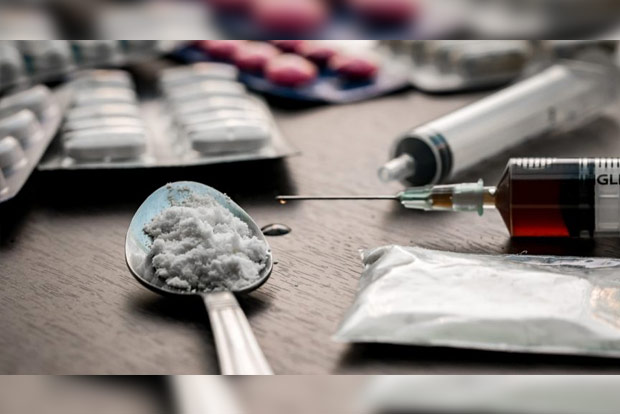Begin typing your search...
Myanmar drug surge worry for neighbours including India
A spike in illegal narcotics from the 'Golden Triangle' to South and Southeast Asian countries as a result of pandemic-related supply gluts and a likely increase in production is worrying Myanmar's neighbours, including India.

Kolkata
The 'Golden Triangle', located in northeastern Myanmar bordering Laos, Thailand and China, is one of the two biggest global sources of narcotic drugs.
Anti-narcotics authorities in neighboring Thailand have seized more than 80 million methamphetamine pills, or yaba, in the past six months, a record haul that they blame partly on a supply glut caused by the Covid-19.
The Assam Rifles that guards India's borders with Myanmar has also reported a significant rise in drug seizures in northeastern states like Manipur and Mizoram but many feel the 'seizures are mere tips of the iceberg".
Assam Rifles DG Lt Gen Sukhdeep Sangwan told IANS during a recent seminar that his traditional counter-insurgency force is "fully geared to meet the drug threat from Myanmar."
"We started by focusing on couriers who cross the border carrying headlines but now we are focusing on the organized cartels operating on the long Frontier. Our pro-active intelligence driven operations are helping bust the drug smuggling rackets," Sangwan said.
Some big seizures in Mizoram and Manipur by Assam Rifles may have turned the heat on the drug cartels operating on India-Myanmar border , but the boom in production is Myanmar remains a cause for worry.
2020 was boom year for Myanmar's drug trafficking syndicates, with the United Nations Office on Drugs on Crime (UNODC) reporting a sharp drop in the price of methamphetamines in East and Southeast Asia to its lowest level in 10 years.
That was because the market was overwhelmed with supply.
This boost owes to cartels in 'Golden Triangle', like the United Wa State Army (UWSA), developing the ability to produce the ingredients to manufacture various synthetic drugs, including amphetamine-type stimulants like crystal meth and yaba, as well as synthetic opioids.
This innovation has enabled drug traffickers to avoid restrictions on the import of precursors such as pseudoephedrine and ephedrine, particularly from China.
"This development has allowed transnational criminal networks to flourish and expand their operations despite the economic recession prompted by COVID-19," said an UNODC report.
The steady increase in meth production has been reflected in the region's seizures: Asian anti-drug authorities confiscated a record 139 tons of meth in 2019, up from 127 tons in 2018 and 82.5 tons in 2017, according to UNODC data. Data for 2020 was not available but UNODC say they will be close to 150 tons.
The UNODC has warned that the region should brace for a larger flow of illegal drugs as the crisis in Myanmar deepens, and the formal economy all but collapses amid strikes, protests, and increasingly violent crackdowns by the security forces.
Organized drug cartels and their militias in eastern Myanmar will consolidate their control, thriving on the chaos unleashed by the February 1 military takeover, Jeremy Douglas, who heads the UNODC office in Bangkok, told IANS.
"If past actions are an indicator of what's coming, then we're likely to see another increase in synthetic drug production," Douglas said.
"The best way to make big money fast is the drug trade, and the pieces are in place to scale up."
As with Covid-19, chaos for Myanmar is opportunity for the region's drug trafficking syndicates.
Over the past two decades, meth production has jumped up in Myanmar, displacing the opium and heroin production in the 'Golden Triangle' .
Much of this is concentrated in Shan State, especially in regions controlled by dozens of micro-militias linked to the Myanmar military, as well as in regions under the sway of non-state armed groups like the United Wa State Army.
The International Crisis Group puts the total value of the Golden Triangle drug trade at around $40 billion per year.
The worry for India and Bangladesh emerges from a dynamic shift in the Burmese illicit drug industry. Smaller cartels like the Wei Brothers, Zhang Ming group and Lo Hsin Nian group have moved their production facilities to Western Myanmar on borders with India and Bangladesh .
They were forced to do so over the years by bigger cartels like Khun Sa's Mong Tai Army (top heroin producer) and UWSA (top meth producer).
These smaller cartels enjoy the protection of the Burmese military and they often use some northeastern rebel groups and Rohingya militants to transport narcotics into India and Bangladesh.
" The presence of these cartels on our borders , their links to Burmese military and their use of some of our insurgents, creates new challenges for our drug enforcement agencies and border guarding forces," says former Intelligence Bureau official Benu Ghosh.
He says Indian agencies and forces like Assam Rifles must gear up to meet the challenge by developing greater inter-agency coordination and drug-related intelligence must be beefed up.
Visit news.dtnext.in to explore our interactive epaper!
Download the DT Next app for more exciting features!
Click here for iOS
Click here for Android
Next Story



